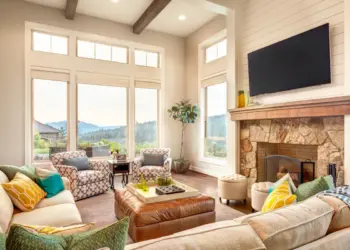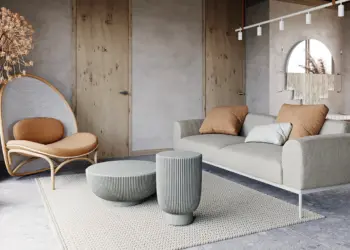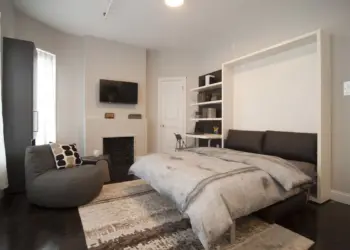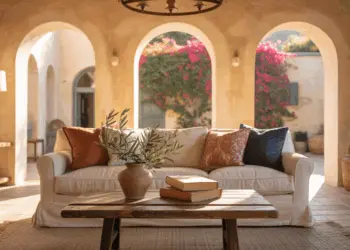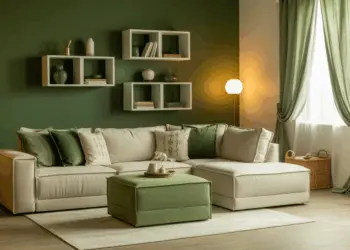A well-thought-out living room layout is crucial to achieve a space that is not only functional but also visually appealing. In this article, we will delve into various tips and ideas to help you design your dream living room layout, one that caters to your lifestyle and reflects your unique personal style.
From strategically placing the sofa to selecting the perfect flooring, we’ve compiled a collection of essential tips to help you design and decorate a practical and convivial living room that is sure to be the heart of your home.
Designing a living room can be a rewarding yet challenging task. As a multifunctional space at the heart of the home, the living room demands careful consideration. To ensure a successful design, here are some essential key points to keep in mind from the very beginning.
Think on the Room’s Function
Before diving into the design process, consider how you intend to utilize the living space. Will it serve as an area for gaming or reading, or will it primarily be used for lounging and watching TV? The function of the room will greatly influence the living room layout and the choice of furniture. By understanding the intended purpose, you can create a layout that perfectly suits your needs and lifestyle.

Define the Focal Point for living room layout
Establishing a focal point is crucial for every living room as it creates a prominent feature that draws attention and unifies the space. Whether it’s a fireplace, a large window with a captivating view, or an elegant entertainment unit, having a focal point serves as a natural anchor for your living room layout. Arrange your furniture around this central element to achieve a sense of balance and flow within the space, making it visually appealing and inviting.

Create a Flow of Traffic in your living room layout
Ensuring ample space for easy mobility is essential in creating a functional and comfortable living room. Arrange the furniture in a way that promotes easy access and avoids obstructing entrances or pathways. When planning your living room layout, avoid placing furniture in front of windows to allow natural light to flow freely and create an open and airy ambiance. A well-designed living room with sufficient space for movement will enhance the overall flow and functionality of the space, making it a pleasant and inviting area for everyday living.

How To Select the Proper Seating for your living room layout ?
Selecting cozy and appropriately sized seating is crucial in designing a comfortable and functional living room layout. Combining sofas, armchairs, and ottomans can provide a range of seating options for different occasions and preferences. When planning your living room furniture, consider the number of family members and guests you expect to accommodate regularly, ensuring there are enough seating options to comfortably accommodate everyone. By carefully choosing the seating arrangements, you can create a welcoming and inviting space that encourages relaxation and socialization in your living room.
First Start by placing the sofa:
The sofa serves as the central element that influences the entire living room layout. Typically, it is positioned against a wall to maximize space, but it can also be placed across the room, acting as a divider between two distinct areas, such as the living and dining spaces.
When arranging the sofa, consider the room’s natural light and focal points, such as a coffee table, a beautiful view, a fireplace, a relaxation area, or a TV. The orientation of the sofa should be chosen to optimize these features and draw attention to the desired focal point.
After placing the sofa, it’s essential to create a living room plan that aligns with your preferences and functional needs. This plan will help you visualize the overall layout, allowing you to arrange other furniture pieces, such as chairs, tables, and storage units, to create a cohesive and harmonious living room design that reflects your style and lifestyle.

Arrange furniture to suit your daily routine and the living room layout
The living room serves as the heart of the home, catering to the needs of each family member. When designing your living room, consider how you and your family live in the space. Take into account the number of occupants, predominant activities, and the time of day the room is most used. The layout should be tailored to your daily life.
If you have young children, leave some open floor space for them to play. For dining purposes, position the table close to the kitchen with a nearby cabinet for storing dishes. Determine the optimal distance between the sofa and TV for comfortable viewing.
In a small living room, opt for a sofa facing one or two additional seats like armchairs, poufs, or floor cushions. Use multipurpose furniture, such as a coffee table with storage or a bookcase acting as a partition, to maximize functionality.
If your living room is a cozy sanctuary, arrange the layout around a focal point, such as a fireplace, and keep the spacing between elements minimal, around 60 cm. To foster social interaction, place several armchairs opposite the sofa, or consider incorporating two sofas if the space permits, creating a conversational area. In all arrangements, be mindful of circulation space to ensure easy movement throughout the room. With thoughtful planning, you can design a living room that caters to your family’s lifestyle and creates a warm and inviting atmosphere for everyone to enjoy.

Care for the light
From morning to night, the living room requires ample light to accommodate its various activities. If possible, when designing your home, consider a south-facing orientation with large windows to maximize natural light. Once the living room is furnished, position the sofa area near a window to benefit from the abundance of natural light. Opt for light colors in the decor to create a sense of openness and to enhance light reflection throughout the space.
Since the living room serves as a versatile room for reading, working, dining, playing, and chatting, it’s essential to incorporate multiple direct and indirect light sources. For the primary light source, consider a pendant light, a large floor lamp, or spotlights to provide ample illumination. To cater to different activities, complement the main light with task-specific fixtures. Add a reading light next to the sofa, a floor lamp near the games corner, and a small lamp on the mantelpiece to create suitable lighting for each function.
Using dimmers is also an excellent option for achieving flexibility in lighting. Dimmers allow you to adjust the brightness according to the mood and specific activities, providing a pleasant and adaptable living room experience. With a well-planned lighting setup, your living room will become a comfortable and enjoyable space for all your daily needs and moments of relaxation.

Tv in the living room layout
When deciding where to place the TV in the living room, consider the layout and how it will impact the overall functionality of the space. One popular option is to mount the TV on the wall above the fireplace, which creates a focal point and saves floor space. Alternatively, placing the TV on a media console against a wall provides a dedicated space for media devices. You can also integrate the TV into a built-in wall unit or shelving system to seamlessly blend it with the room’s decor. Regardless of the choice, ensure the viewing angle and distance from seating areas are comfortable for an enjoyable TV-watching experience for everyone in the living room.

How to make the best of the fire place in your living room?
Enhancing the ambiance and coziness of the living room can be achieved by making the best of a fireplace. Start by arranging the furniture around the fireplace, creating a focal point that draws attention to the warm and inviting hearth. Comfortable seating like sofas and armchairs facing the fireplace encourages gatherings and relaxation. Utilize the mantel as a display area for decorative items, such as artwork, candles, or family photos, adding a personal touch to the living room. In colder months, a basket of firewood nearby can add rustic charm.
For added elegance, consider installing a mirror above the fireplace to reflect natural light and make the room appear more spacious. During warmer months or when the fireplace is not in use, you can transform it into a stylish display with decorative logs or a creative arrangement of plants. By incorporating these design elements, the fireplace can become the heart of the living room, creating a cozy and welcoming atmosphere for family and guests alike.

Create Conversation Areas in your living room layout
Create discussion zones in the living room layout by strategically placing furniture to encourage interaction and socialization. Arrange couches and chairs together to foster a relaxed atmosphere for conversations and gatherings. To further define these discussion areas and add a touch of warmth and richness to the living room, consider incorporating area rugs.
Area rugs can play a vital role in delineating different sections of the living room. Placing a rug under the seating arrangement helps anchor the furniture group, creating a cohesive and inviting space. Opt for rugs that complement the overall color scheme and style of the living room, enhancing the visual appeal and comfort of the seating areas.
By using area rugs, you not only define conversation zones but also add texture and coziness to the living room. Rugs create a sense of intimacy and help tie together the various elements of the space, contributing to a harmonious and well-designed living room layout. So, when arranging your living room furniture, consider the strategic placement of area rugs to enhance the social aspect of the room and create an inviting and pleasant ambiance for all.

Utilize Storage Solutions
Including storage solutions in the living room layout is a smart way to maintain a tidy and clutter-free space. With thoughtful storage options, you can keep items like toys, books, and remote controls neatly organized and out of sight, contributing to a more inviting and relaxing atmosphere.
Built-in shelves and cupboards offer a stylish and seamless storage solution. They not only keep your belongings organized but also add to the overall design and aesthetics of the living room. You can use these shelves to display decorative items or store everyday essentials, creating a balanced and well-curated look.
Chic storage ottomans serve a dual purpose by providing a comfortable seating option while also offering hidden storage space. They are perfect for stashing away blankets, pillows, or other items that you want to keep close at hand but neatly tucked away.
By incorporating these storage solutions into your living room layout, you can maintain a clutter-free environment, promoting a sense of calm and relaxation. An organized and welcoming living room invites you and your guests to enjoy the space fully, making it a hub of comfort and convenience for all.

Consider Room Traffic
Be mindful of how people enter the living room from other parts of the house. In particular, if your living room acts as a vital hub for the layout of your home, make sure there is straightforward access to and from any adjacent rooms. This ensures a seamless flow of movement and connectivity between different areas, making the living room a central and inviting space for everyone to gather and interact.



